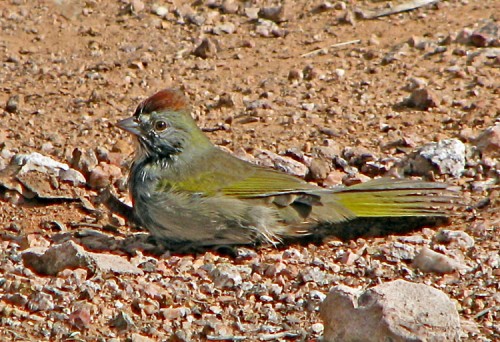Touch the Tiny Toad!
Monday was International Touch the Tiny Toad Day, with bonus Whiptail. I guess the whiptail makes it more correctly International Touch the Reptile Day, except it wasn’t international, it was just in our yard, and a toad isn’t a reptile, but then again, it was a tiny Spadefoot, whic h isn’t a toad but a toad-like amphibian, although an amphibian still isn’t a reptile. But it was tiny, and I touched it.
h isn’t a toad but a toad-like amphibian, although an amphibian still isn’t a reptile. But it was tiny, and I touched it.
Couch’s Spadefoot, Scaphiopus couchii, (photo E.Shock) >>
At any rate, I ended the day having made contact with two herptiles: a Spadefoot toadlet which E rescued out of the pool and I held on my palm while he snapped its portrait in the rosy light of sunset, and a Sonoran Tiger Whiptail (Aspidoscelis tigris punctilinealis) which I’d rescued out of the pool earlier but didn’t get a picture of because it zipped into the cover of the fan palm as soon as I lifted it onto the deck.
Normally I go weeks if not months between making direct contact with a yard herp, so this was a kind of blue moon event, as far as handling neighborhood non-mammals goes. Both whiptails and spadefoots have very soft, smooth belly skin, cool and heavy like silk. (FYI: if you ever find a whiptail in your pool, go ahead and rescue it by hand — I’ve never had one try to bite, unlike some other lizards I could mention. If you rescue a spadefoot — or any toad — wash your hands afterwards: many have toxins in their skin, and Couch’s toxins pack an eye-swelling wallop, I understand.)
The question remains: was this tiny toadlike toddler an offspring of one of the Couch’s spadefoots we released in September 2008? It’s about the same size as those hatchlings were — that would make today’s youngster “young of the year”, and the first evidence that our releases had reproduced. (Of course, it could have washed in from uphill during the August flash flood.) But still, in past years we’ve found larger spadefoots in the pool (right>>) which we’ve assumed were “ours” from ’08, and they were way bigger than this lil dude, so we’re figuring he’s a subsequent generation.
and the first evidence that our releases had reproduced. (Of course, it could have washed in from uphill during the August flash flood.) But still, in past years we’ve found larger spadefoots in the pool (right>>) which we’ve assumed were “ours” from ’08, and they were way bigger than this lil dude, so we’re figuring he’s a subsequent generation.
In the top picture, take a look at the spadefoot’s hind leg, underneath his foot. See that small black dash that looks like a piece of crud on my hand? That’s his little “spade”: a hard, dark digging organ situated under each back foot, which gives him his name in both English (spadefoot) and Greek (scaphiopus). Actually, you can also see it on the left foot of the spadefoot in the pool photo, too. Click on this link to the Calherps website to see lots of Couch’s spadefoot photos, and scroll to the very bottom to see great shots of their spades.
And, because I didn’t get a photo of the whiptail, here’s a bonus Green-tailed Towhee (Pipilo chlorurus, photo E.Shock — E is on a roll, being in the right place at the right time with his camera!) Green-tailed towhees are Arizona natives, but they breed in mid- to high-elevations, so it’s just passing through our yard — although it’s possible it could stay for the winter. It looks legless because it’s belying its rep for being a secretive bird by taking a dust bath out in the open. And it looks spiky because it’s molting in fresh plumage, especially around its face, and the new feathers are still wrapped in a protective keratin casing, like the tips of shoelaces. The shoelaces’ pushing out makes a towhee itchy, and that’s probably why it’s rolling around in the gritty gravel, scratching its itchy bits. Itchy itchy towhee.
but they breed in mid- to high-elevations, so it’s just passing through our yard — although it’s possible it could stay for the winter. It looks legless because it’s belying its rep for being a secretive bird by taking a dust bath out in the open. And it looks spiky because it’s molting in fresh plumage, especially around its face, and the new feathers are still wrapped in a protective keratin casing, like the tips of shoelaces. The shoelaces’ pushing out makes a towhee itchy, and that’s probably why it’s rolling around in the gritty gravel, scratching its itchy bits. Itchy itchy towhee.

Great shot of the green-tailed towhee! Lizards are very bity, aren’t they? I’ve had Desert Spinies close down on my fingers during rescues (as opposed to recoveries) and man, are they strong.
‘the new feathers are still wrapped in a protective keratin casing, like the tips of shoelaces.’
what an image–thanks, I’ll not forget that one.
Out to try my new binoculars today. A modest set, but better in any case. I hope my new glasses will be as sharp!
[…] edge looking for a way out, but it doesn’t take them long to tire and drown. When I’ve scooped survivors out of the pool, it’s always an amazing sensory experience — their limber bodies are sleek and satiny, […]
[…] was a fairly well-grown Spadefoot. As I’ve mentioned here in the past, Spadefoots are not technically toads, although you’d never know by looking, or […]